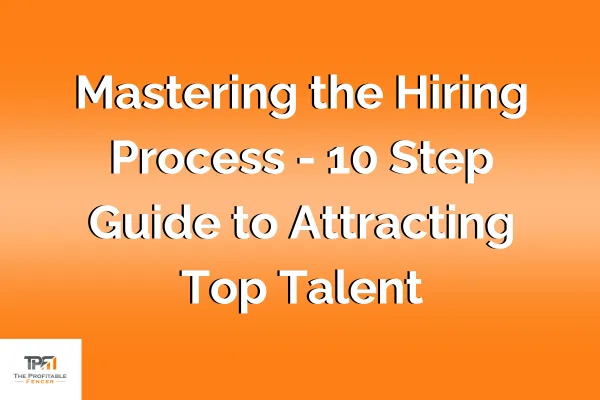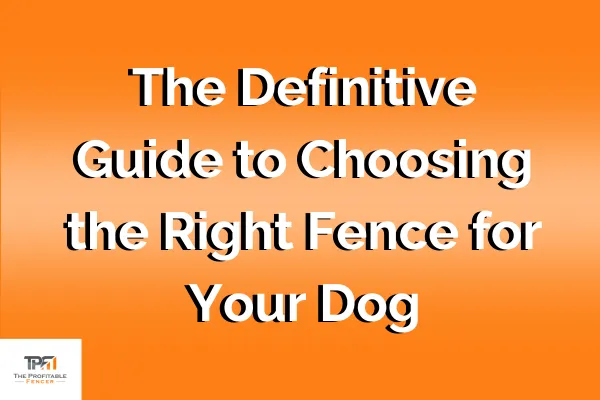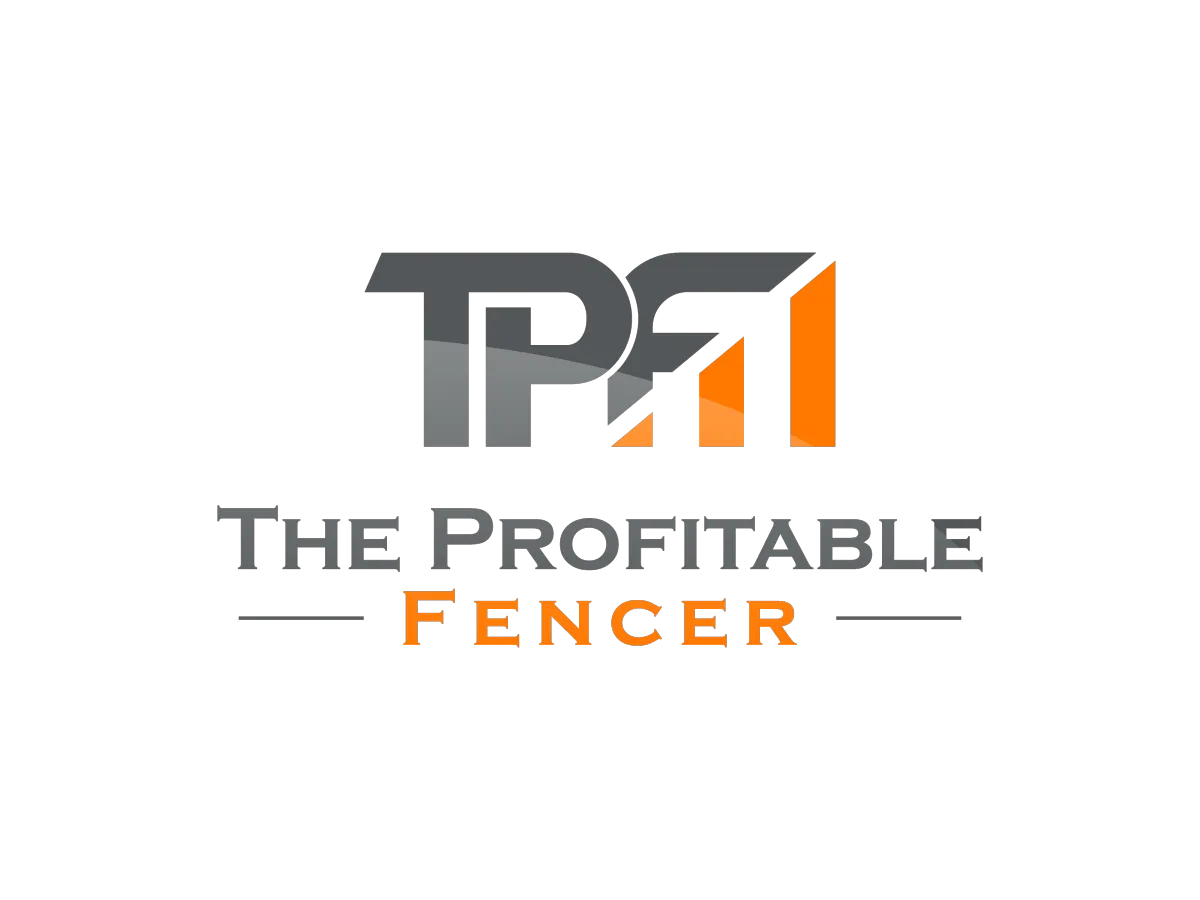Checkout My Blogs

Mastering the Hiring Process - A 10 Step Guide to Attracting Top Talent
As fence contractors, installers, and business owners, we know the importance of a strong, reliable team. However, finding suitable workers can be a challenge. I know something about that- my company went through 109 staff in 4 years because we took anybody in without too much of a process. This episode will walk you through a 10-step process to ensure you attract and hire the best talent for your business and also retain them without leaving any doubt in your mind as to who is a good fit & who is not a good fit for your company.


The Definitive Guide to Choosing the Right Fence for Your Dog
"The Definitive Guide to Choosing the Right Fence for Your Dog"
Height Matters
As a fencing expert with three decades of experience and a passionate pet lover, I understand the importance of selecting the perfect fence height to ensure the safety and security of your beloved canine companion. In this guide, we'll explore the various factors to consider when determining the ideal fence height for your dog, from size and breed considerations to aesthetic appeal and neighbor relations.
Size and Breed Considerations
The first step in choosing the right fence height for your dog is to consider their size and breed characteristics. Larger breeds, such as German Shepherds or Great Danes, require taller fences to prevent them from easily jumping over or scaling the barrier. Similarly, breeds known for their agility and athleticism, like Border Collies or Australian Shepherds, may also require taller fences to contain their energy and curiosity.
Escape & Prevention
One of the primary purposes of a fence is to prevent escapes and keep your dog safely contained within your property. A too-short or easily scalable fence may provide little deterrence for a determined escape artist. You can effectively prevent escapes and ensure their safety by selecting an appropriate fence height based on your dog's size and abilities.
Assessing Jumping Capabilities
Before deciding on the height of your fence, take the time to assess your dog's jumping capabilities. Spend time observing their behavior around existing barriers or obstacles to gauge their ability to jump or climb. Consider factors such as their age, agility, and any previous escape attempts. This information will help you determine whether a taller fence is necessary to effectively contain your pet.
Future Growth
It's essential to consider your dog's potential growth when selecting fence height, especially if you have a puppy or young dog. A fence that may be sufficient to contain a small puppy could become inadequate as they grow into larger, more powerful adults. Investing in a taller fence from the outset can prevent the need for costly upgrades or modifications in the future.
Neighbor Considerations
In addition to containing your dog within your property, consider the impact of your fence height on neighboring properties. A taller fence may obstruct views or sunlight for neighboring properties, potentially leading to disputes or complaints. Communicate with your neighbors and adhere to any local regulations or neighborhood guidelines regarding fence height to maintain positive relationships.
Aesthetic Considerations
While functionality and security are paramount, it's also important to consider the aesthetic appeal of your fence. Choose a fence height that complements the architectural style of your home and enhances the overall curb appeal. Fortunately, there are various fencing options available in different heights and designs to suit your preferences while still meeting the needs of your dog.
By carefully considering size and breed characteristics, escape prevention, assessing jumping capabilities, future growth, neighbor relations, and aesthetics, you can select the perfect fence height to ensure the safety and security of your canine companion while enhancing the beauty of your property. Stay tuned for more expert tips on creating a pet-friendly outdoor space with the right fencing solutions.
Avoiding Gaps
Understanding the Risk:
Pets, particularly curious ones like dogs and cats, are naturally inclined to explore their surroundings. When there are gaps in the fence, they may attempt to squeeze through in pursuit of something enticing or out of sheer curiosity. This poses a significant risk as it can lead to escape, injury, or even entrapment.
Choosing Suitable Fencing Designs:
When selecting a fence for your pet-friendly yard, opt for designs with closely spaced slats or panels. Solid panel fences, such as vinyl privacy fences or wooden panels, are excellent choices as they leave minimal room for pets to slip through. Alternatively, if you prefer a chain-link fence, ensure that it has smaller mesh sizes to reduce the risk of escape.
Narrowing the Gaps:
It's crucial to ensure that any gaps in the fence are narrow enough to prevent even the smallest pets from escaping or getting stuck. Measure the spaces between slats or panels carefully during installation, ensuring they are narrower than the width of your pet's body. This prevents them from squeezing through or becoming trapped between the gaps.
Considering Different Pets:
Keep in mind that different types of pets have varying abilities to navigate gaps in fences. While dogs may attempt to push through or dig under a fence, cats are notorious for squeezing through small openings or climbing over barriers. Tailor your fence design to accommodate the specific needs and behaviors of your pets to ensure their safety and containment.
Regular Maintenance:
Even with a well-designed fence, regular maintenance is essential to ensure gaps do not develop over time. Inspect the fence periodically for any signs of wear, damage, or shifting that could create openings. Promptly repair any gaps or loose components to maintain the integrity of the enclosure and prevent potential escapes or accidents.
Training and Supervision:
While a secure fence is crucial for pet safety, proper training and supervision also play a vital role in preventing escape attempts. Train your pets to understand and respect the boundaries of the fenced area through positive reinforcement and consistent reinforcement. Additionally, supervise your pets while they're outdoors to intervene if they attempt to breach the fence.
By prioritizing the elimination of gaps in your fence design and ensuring that any openings are narrow enough to prevent escape or entrapment, you can create a safe and secure outdoor space for your pets to enjoy. A pet-friendly fence design provides peace of mind, knowing that your furry companions are safely contained within the boundaries of your yard

